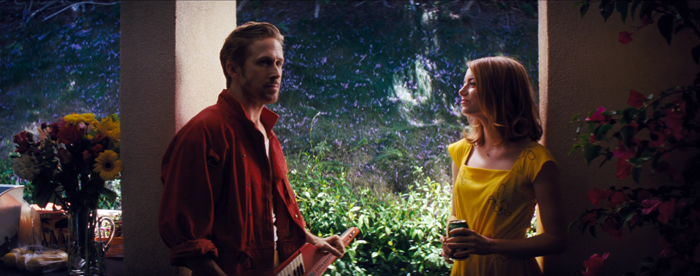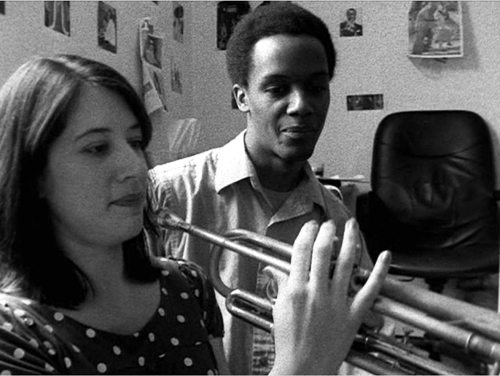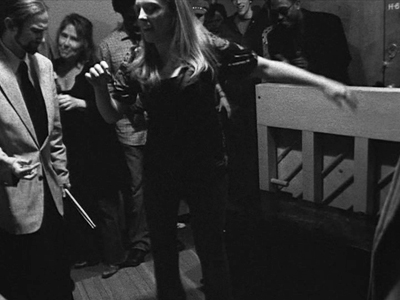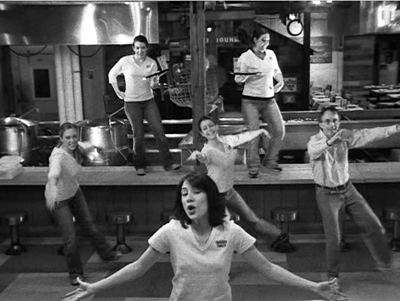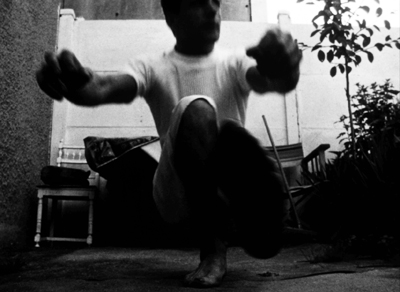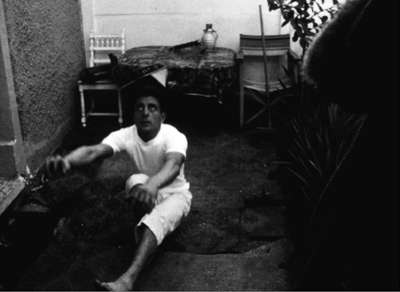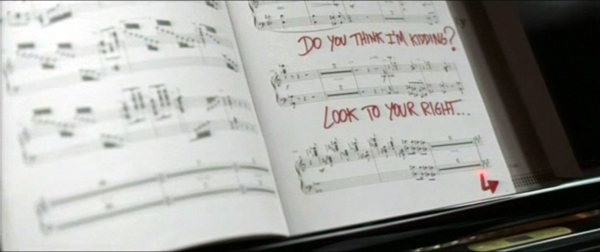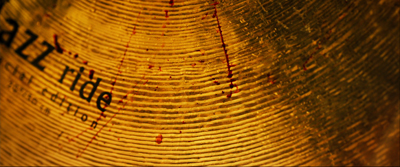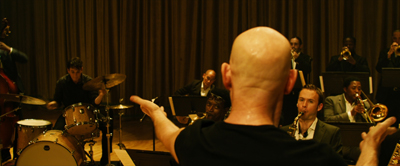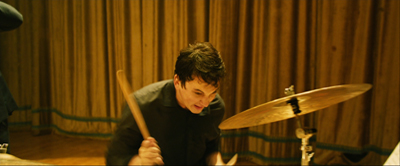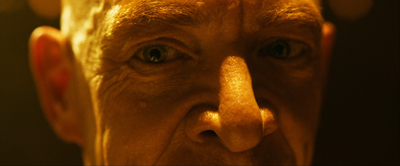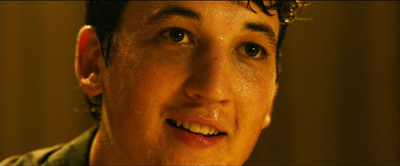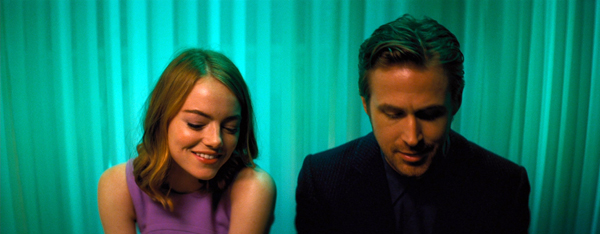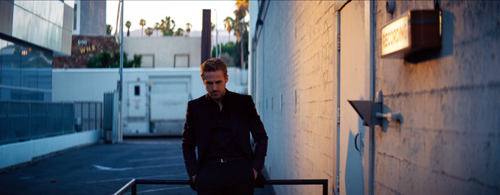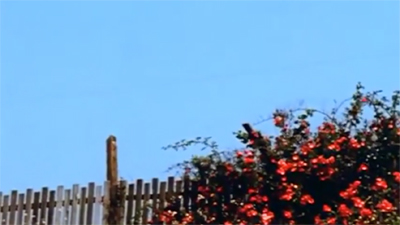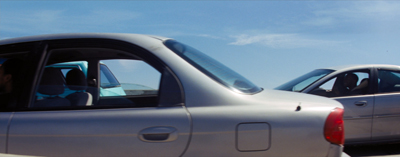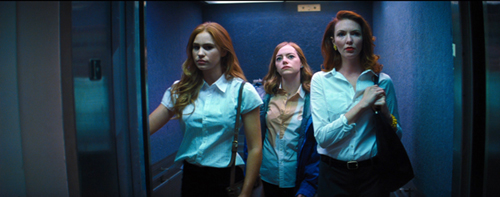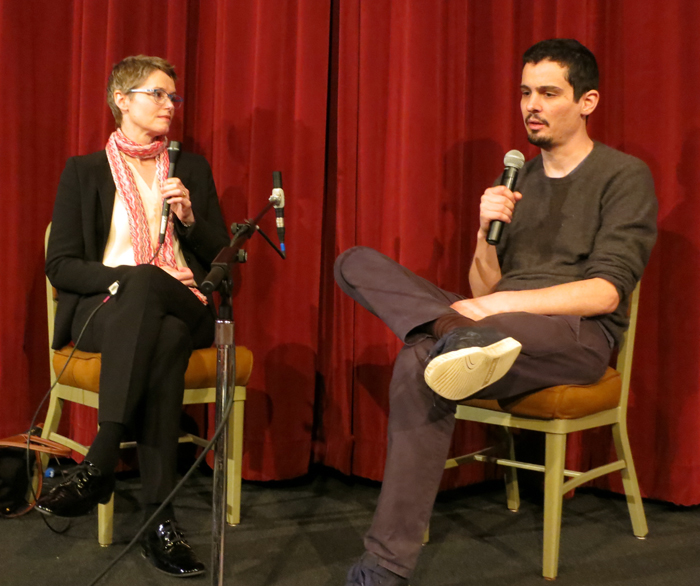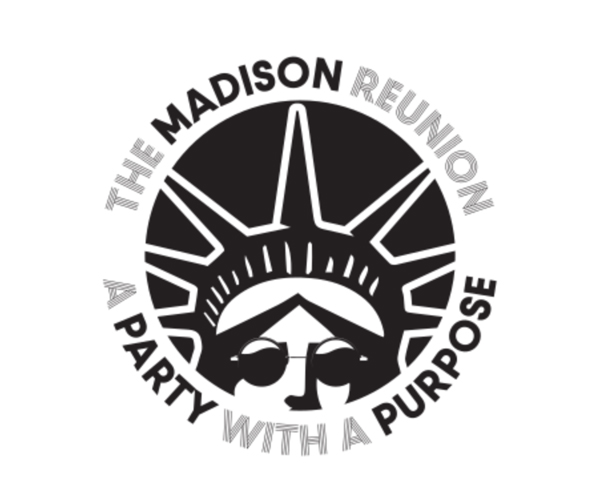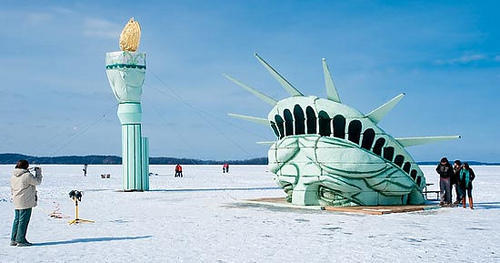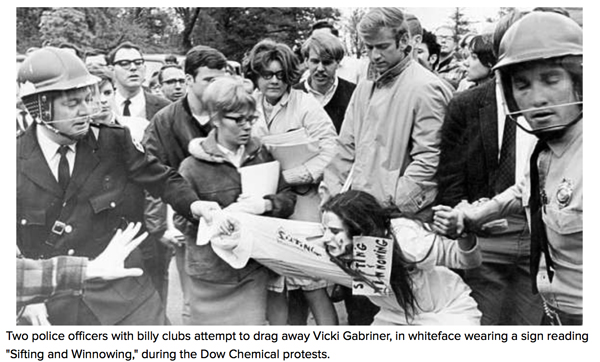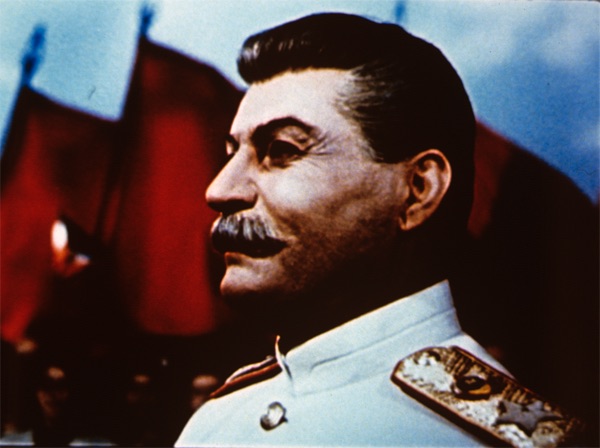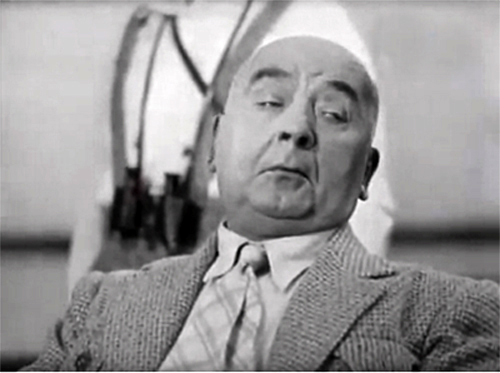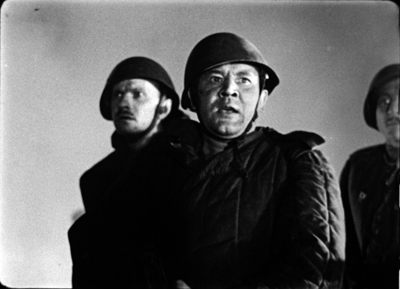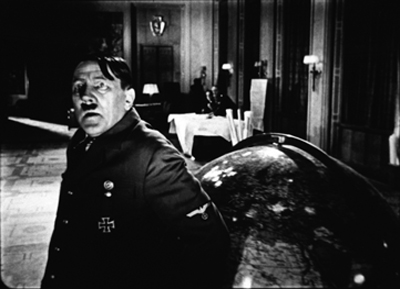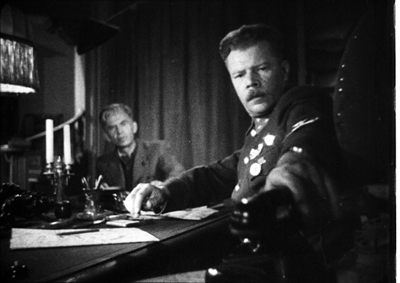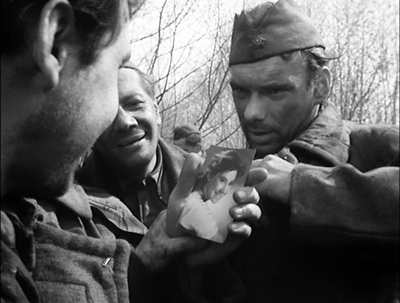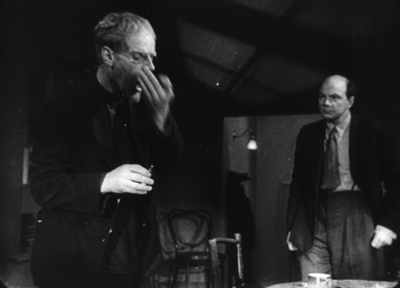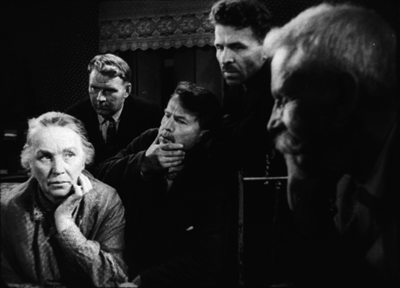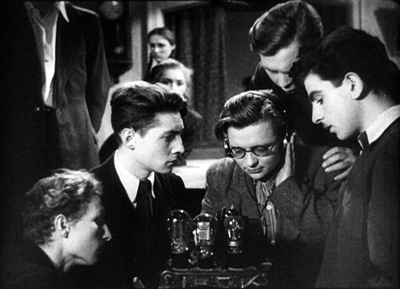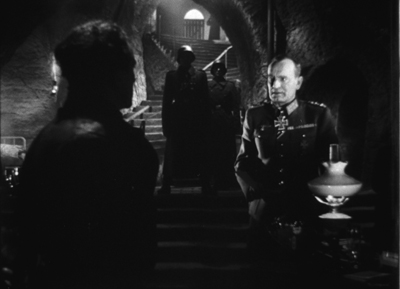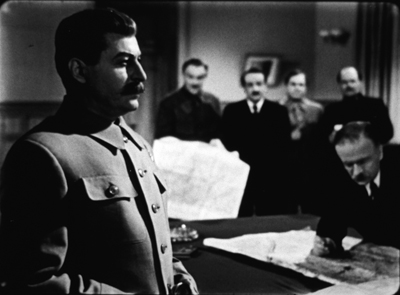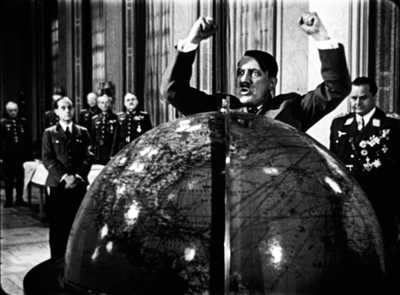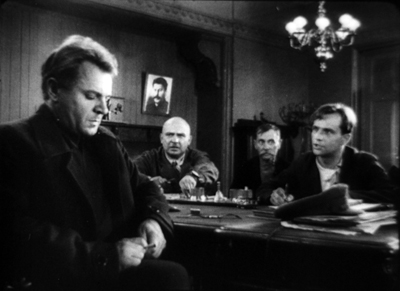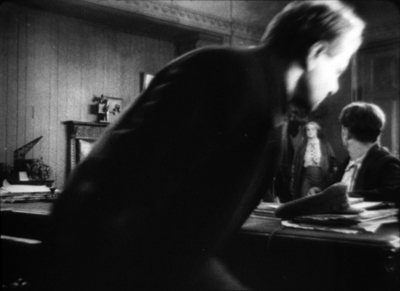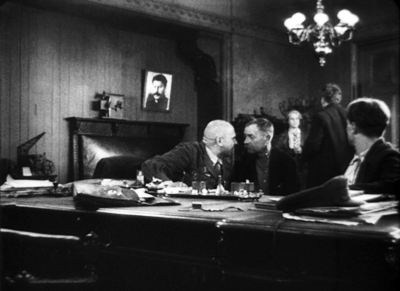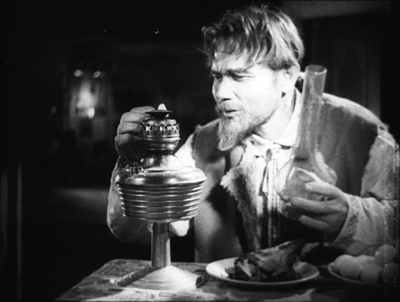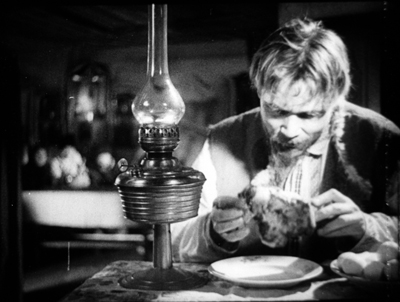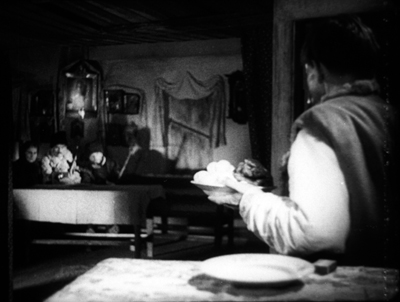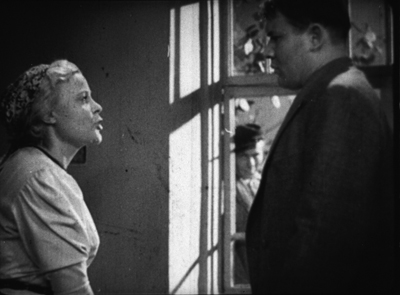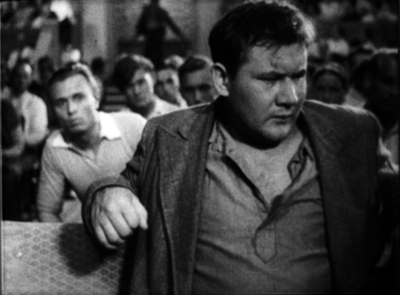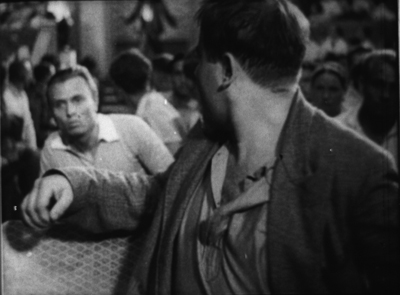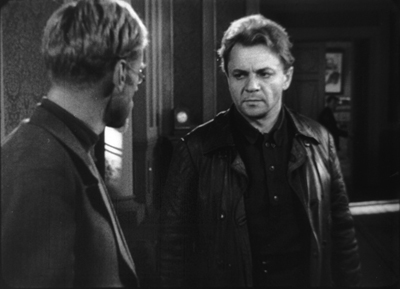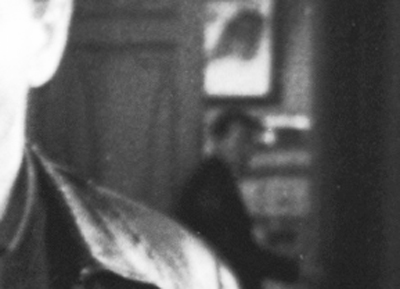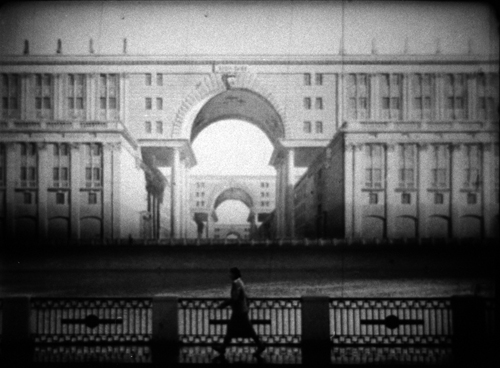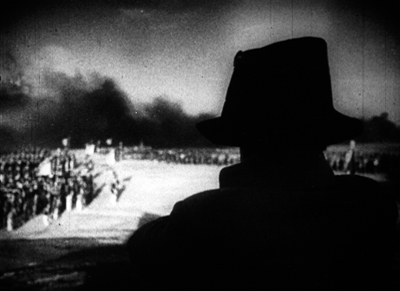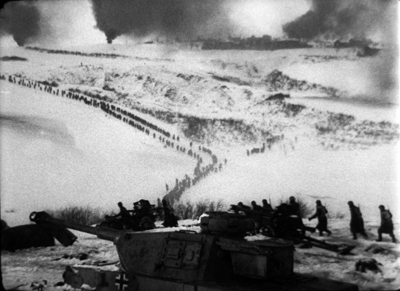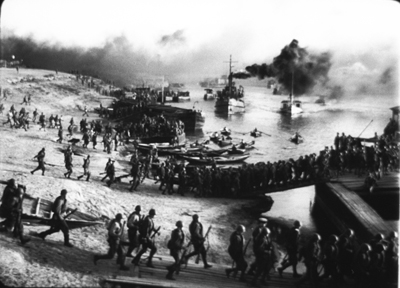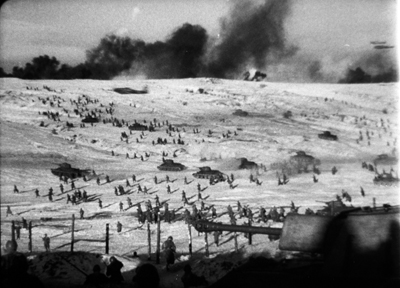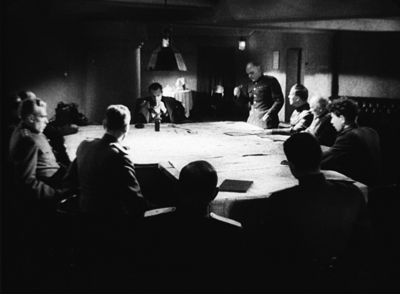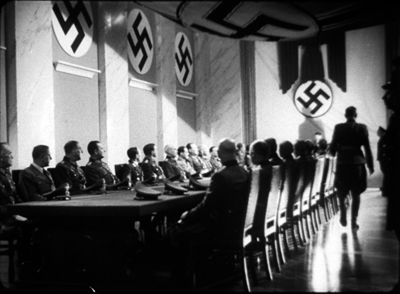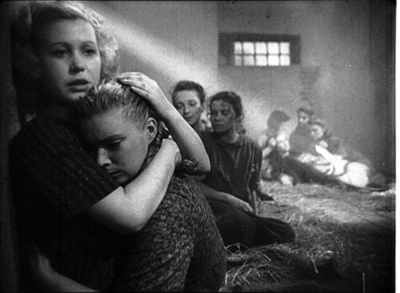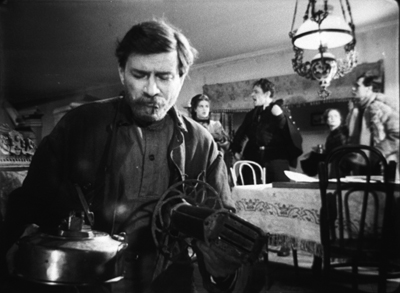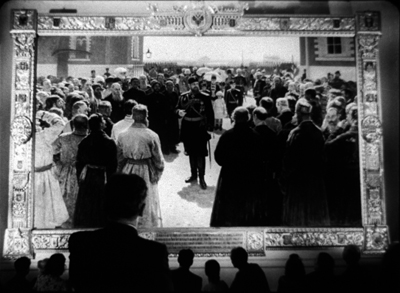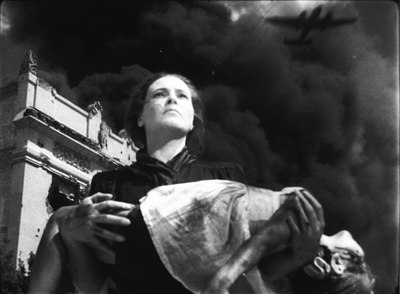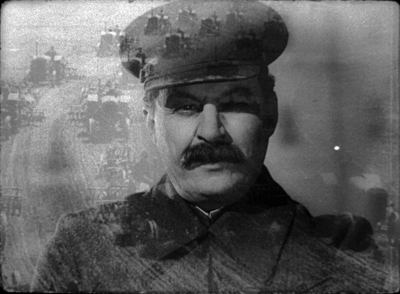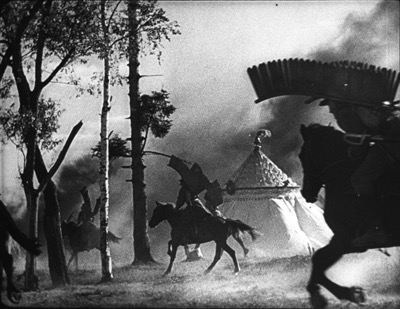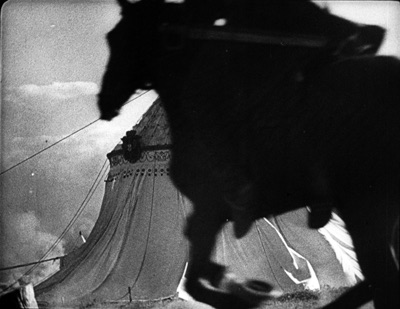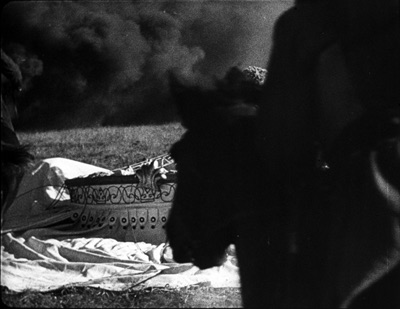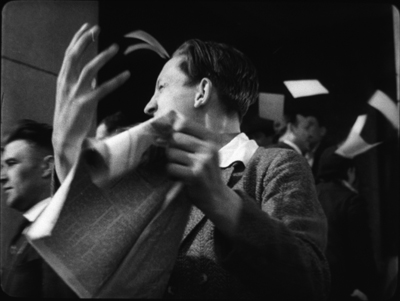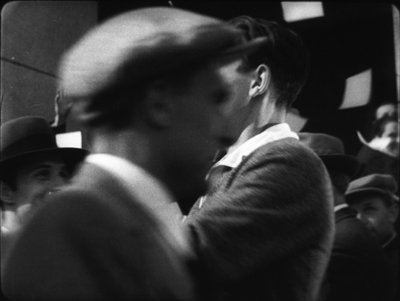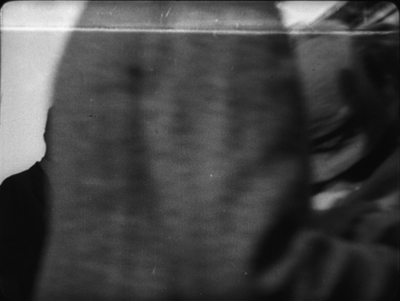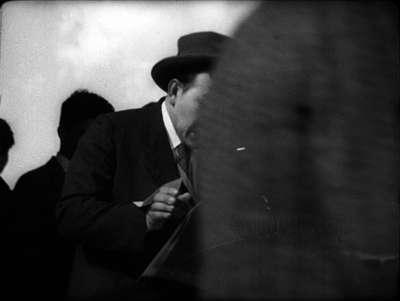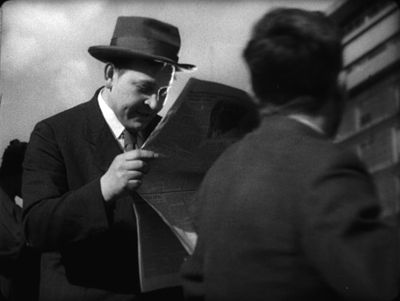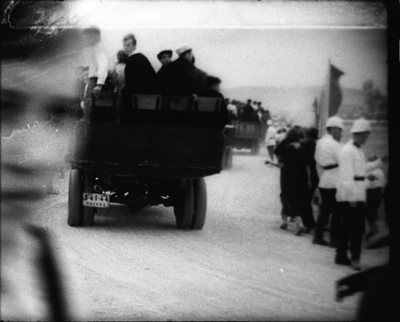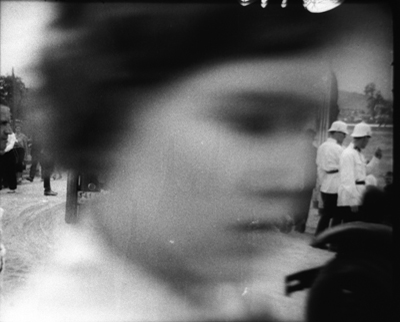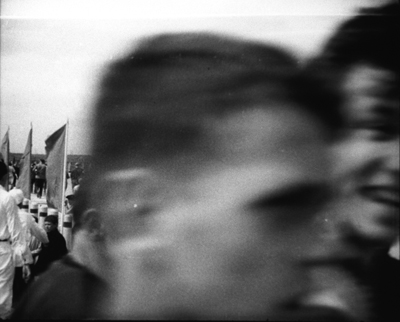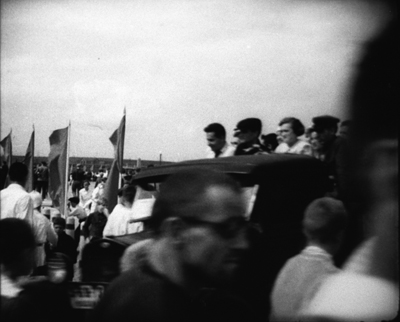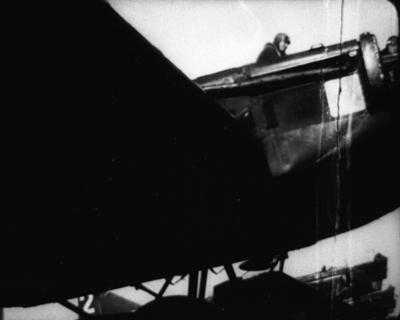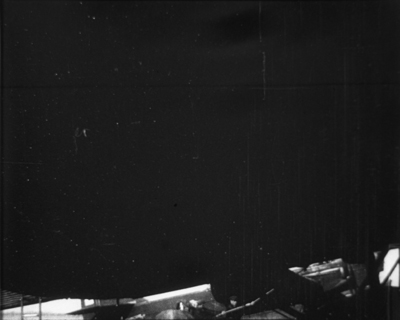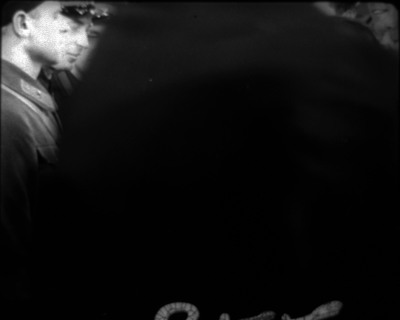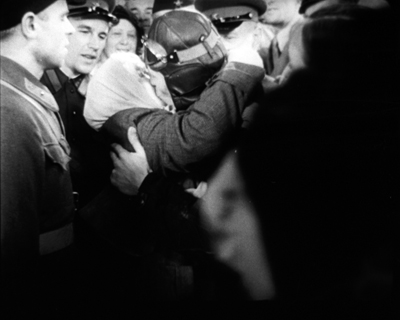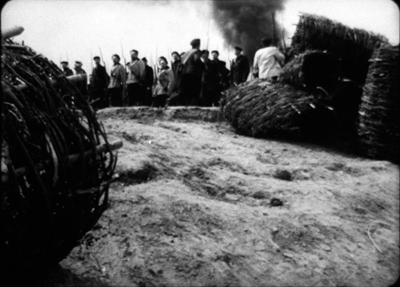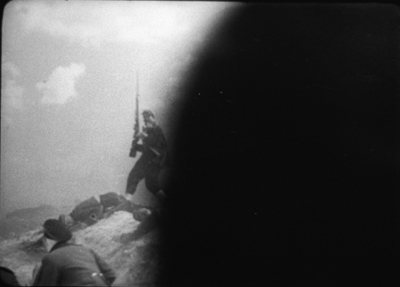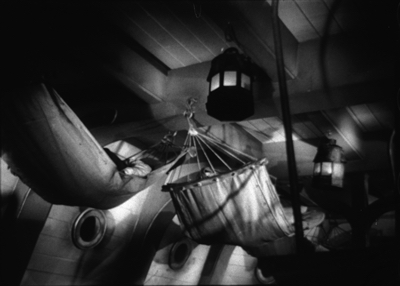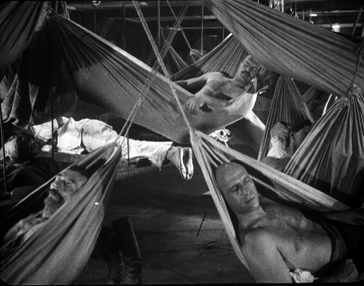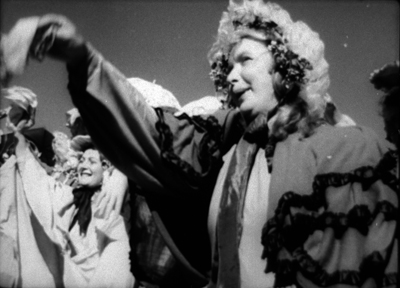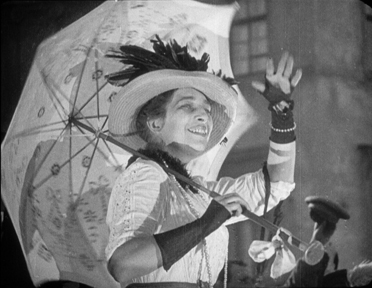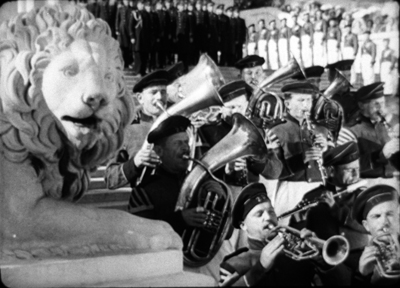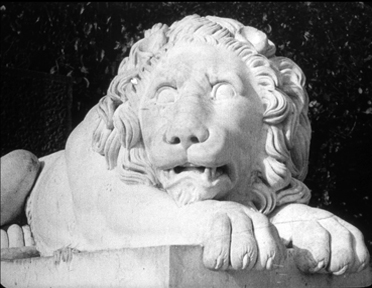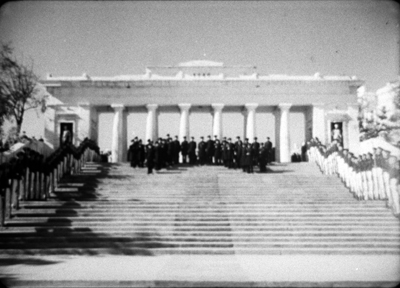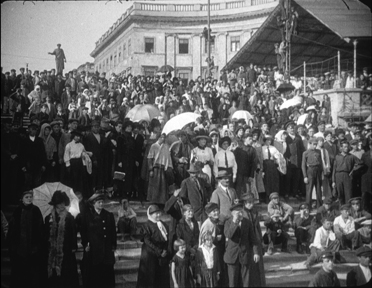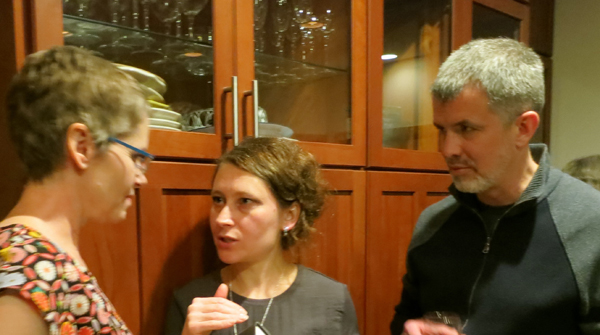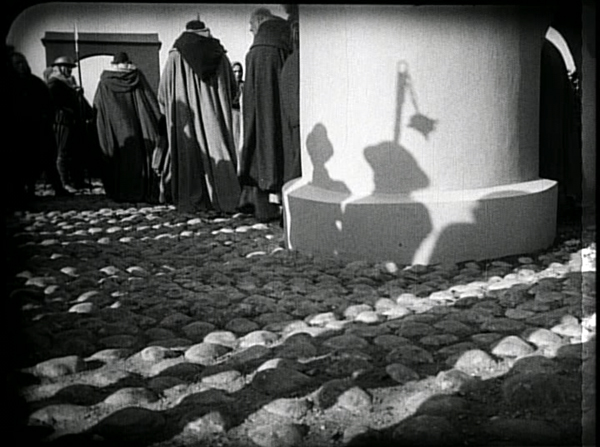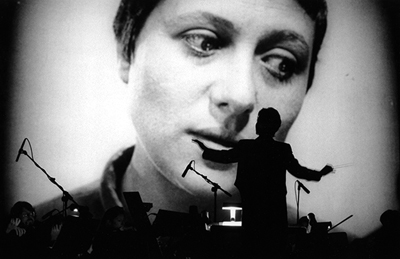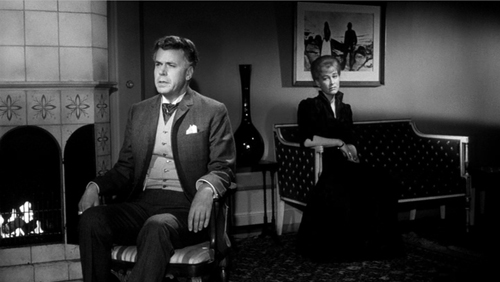Archive for the 'UW Film Studies' Category
New colors to sing: Damien Chazelle on films and filmmaking
La La Land.
DB here:
Between the end of principal photography on First Man and the start of post-production, Damien Chazelle squeezed in a visit to the UW–Madison. We’re very glad he did. A hell of a time was had by all.
His visit culminated a Cinematheque series devoted to his work. On Friday 23 February we picked him up at O’H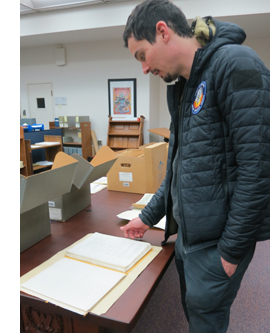 are and had a fine ride back talking about film and less important things. Then he visited our archives at the Wisconsin Center for Film and Theater Research; on the right, he examines an original Final Revised script of Citizen Kane.
are and had a fine ride back talking about film and less important things. Then he visited our archives at the Wisconsin Center for Film and Theater Research; on the right, he examines an original Final Revised script of Citizen Kane.
After that, he sat down for a conversation about his career with a hundred or so students. At a quick dinner, he and our Cinematheque impresario Jim Healy gave dueling impersonations of Michael Gazzo as Frankie Pentangeli. Damien then plunged into a long Q & A with a full house who had just seen La La Land in 35mm.
Next morning he met with Criterionistas Kim Hendrickson and Grant Delin for a FilmStruck segment. Then, in a discussion with Kelley Conway, he introduced a string of films he curated for the Cinematheque. But he wasn’t off the hook, because driving back to O’Hare with Kelley and Jeff Smith, he was immersed in more film talk.
Damien proved himself the ultimate guest—friendly and generous, enthusiastic and excited, free of airs and snark. We learned a lot from him. Herewith, a sample.
A Direct-Cinema musical
Guy and Madeline on a Park Bench.
Although he considered a musical career, film was Damien’s first love. He wrote scripts in middle school, transcribed movie dialogue from VHS tapes, and as an undergrad watched films in Harvard’s magnificent archive. The film program there, with leaders like Alfred Guzzetti and Ross McAlwee, stressed documentary and experimental film, and the exposure stuck. Among the films Damien curated for our Cinematheque show were the Rouch-Morin investigation Chronicle of a Summer and Su Friedrich’s Sink or Swim.
No surprise, then, that his first feature, Guy and Madeline on a Park Bench, was shot in a Direct Cinema mode. It’s got light leaks and run-and-gun footage, complete with bumpy handheld pans and zooms. To get around problems of inexperienced actors, Damien told some of them that it was a documentary. The 16mm project was produced over three years; sometimes the exposed films sat in the lab while Damien drummed up donations from friends, family, and strangers. (Writing blind to Harvard alums, Damien got a donation from John Lithgow.) When a processing accident ruined some footage, Damien’s producer talked the lab into free work for a time.
Guy and Madeline cuts among three characters: trumpeter Guy, his ex-girlfriend Madeline, and his new girlfriend Ilena. Like a Nouvelle Vague film, it relies on chance encounters. Madeline is emotionally wrenched by the breakup with Guy, and we follow her efforts to find work and a new partner. Ilena’s semi-reluctant meeting with an older man who brings her home to meet his daughter reminded me of the moment in Shoot the Piano Player when Charlie, running from the thugs, falls into step beside a stranger who tells him his own troubles. And of course the title characters recall the separated lovers of The Umbrellas of Cherbourg.
For all its documentary textures, the film at times becomes what J. Hoberman called a Mumblecore musical. But there’s a gradual shift to the full-blown show-biz mode. Damien talked of the thrilling moment in Hollywood musicals when realistic presentation of a scene gives way to nondiegetic music and the characters leap to a new, more ethereal level. Guy and Madeline presents this transition in gradual doses.
At first, the numbers are motivated realistically. Guy, an African American, plays trumpet with a jazz ensemble, so we get scenes of their performance at a local hangout. We move a bit further toward stylization with a party sequence that induces some talented kids to indulge in singing and tap-dancing among their friends—captured in casually imperfect framings.
The transition to pure musical fantasy comes forward after the breakup in a solo number, with Madeline singing a soliloquy as she wanders in the park. There’s no sense of an audience; this is a private reverie. (A whiff of this tune, heard on a car radio, makes its way into La La Land‘s opening shot.)
When Madeline takes up work at a diner, the components come together in an all-out production number addressed to us.
In an echo of Bande à part’s “Madison” sequence (lucky name), shooting a dance number in cinéma-vérité mode brings out an intriguing friction. It’s the same kind of productive clash we get on the soundtrack, between Justin Hurwitz’s shimmering Legrand-inflected score and varieties of jazz (Dixieland, Guy’s cool composition for Madeline). And like Nouvelle Vague characters, these people are devoted to books, the arts, and self-exploration.
As a “staged documentary” Chazelle’s film parallels Chronicle of a Summer in an intriguing way. That film starts as pure Direct Cinema, with investigators stopping people on the street to ask them questions. But as we get to know the group the film concentrates on, there’s a lot more control and “fictionalization.” There are precise matches on action, for instance, with camera ubiquity indicating careful restaging.
This rigging doesn’t damage the film as a document of summer 1960. Damien learned from it that you can make a truthful movie by “creating a situation with less and less acting to do.” Given this hybrid quality, Chronicle of a Summer becomes a vivid example of a moment when a film mode is “figuring itself out.” Its self-conscious artifice, which includes participants watching themselves during a screening, was foundational for the New Wave. “You watch a language being born.” That language was also political, as Damien pointed out: The film summons up memories of the Holocaust and glimpses of the Algerian war.
In other respects, Damien’s first film looks forward to La La Land thematically and formally. Guy and Madeline starts with the moment of the couple’s breakup (on the bench) and flashes back to vignettes of their love affair before returning to the bench. This opening loop is like the one that jumps from Mia’s night out back to the traffic jam and then follows Sebastian. A large stretch of each film’s plot is about how the couple’s lives converge and diverge.
Similarly, when the signature tune “I Left My Heart in Cincinnati” is played, shots of Madeline and Guy frame a flashback to the combo’s earlier performance, as if they’re sharing the memory. Something similar happens at the climax of La La Land, in what seems to be a mutual vision of Sebastian and Mia’s alternative future. As often happens in Chazelle’s cinema, epiphanies burst out in moments of musical performance.
Blood, sweat, and tears on the drumhead
Grand Piano.
Despite playing many festivals and winning critical praise, Guy and Madeline didn’t open any doors in Hollywood. Damien picked up odd jobs, not all film-related, while writing commercial genre screenplays. He sold a kidnapping script (not made) and Grand Piano (2013), skillfully directed by Eugenio Mira. He began getting assignments like The Last Exorcism Part II (2013) and he contributed to the screenplay for what became 10 Cloverfield Lane (2017), released long after he’d worked on it.
I found Grand Piano pretty impressive on the big screen. Chazelle’s script and Mira’s direction create a solid thriller built around the situation Hitchcock designed for his versions of The Man Who Knew Too Much. Most of the action takes place during a concert celebrating the return of a traumatized pianist to the stage. As he’s about to start the program, a sniper uses cellphone messages and scribbles on the score to demand a perfect performance of the florid piece that spooked the pianist years before.
At first restricted to the pianist, the film’s viewpoint widens gradually to include others, and soon crosscutting builds tension. The tormenting voice (“Play one wrong note and you die”) calls to mind the music teacher in Whiplash. As in a classic thriller, the climax arrives when the victim must fight back. And as in Whiplash, the performer wins using the only weapon he has: nearly crazed virtuosity.
Damien now thinks that the long germination of the scripts for Whiplash and La La Land made them better. As financing kept falling through, the films gained more layers. Whiplash (2014) found a home first, with Blumhouse producing and helping with the financing. It was their idea to shoot a scene to show investors (we screened it in our series), and the project found financing at Bold Films.
Given a $3 million budget and a 20-day schedule, Whiplash demanded meticulous storyboarding and very little coverage. Like Hitchcock and Leone, Damien shot only what he needed. He used two cameras for the rehearsal scenes and three for the climactic concert. The cuts and camera moves were planned to coincide with measures of the music.
Damien calls Whiplash a film about music (the same could apply to Grand Piano). It owes a lot to the sports-film genre as well; Damien envisioned its punishing force as indebted to Raging Bull. He turns big-band drumming into blunt-force trauma, with gory drumheads and cymbals. Sam Fuller would have approved.
Like Guy and Madeline and Grand Piano, Whiplash culminates in a musical performance that carries a powerful emotional impact. No wonder that as a kid Chazelle studied one-reel movies of classic drummers, then started to think of the shorts as films in their own right. In this spirit he curated for us two Dudley Murphy shorts, St. Louis Blues (1929, with Bessie Smith) and Black & Tan (1929, with Duke Ellington), along with the 1954 documentary Jazz Dance, a night on the town that explodes with pure human happiness. In all these, music-making is pushed to the edge of ecstasy.
This time around with Whiplash (good name for a movie about sadomasochistic musicians), I noticed its straightforward classical construction. Damien says that he learned screenplay construction after moving to LA. Its tale of a boy caught between a good but weak father and a punishing, strong one gains strength and sharpness from its traditional four-part plot.
At the crucial 25-minute mark, Fletcher wins Andrew’s trust. Four minutes later, in the performance of “Whiplash,” Fletcher is bellowing and Andrew is sobbing. First reversal noted. The second part, the Complicating Action, interweaves Andrew’s romance with Nicole, his persistence in drumming, and his fraught relation with his family. This part culminates at the midpoint with Fletcher’s giving Andrew a new rival, which impels Andrew to break up with Nicole. In the Development section, Andrew suffers more setbacks. A harrowing car accident leads him to botch a major competition and assault Fletcher. He leaves school, accuses Fletcher of abuse, and abandons drumming.
After he discovers Fletcher playing piano in a club, he agrees to join his new combo, which preciptates the climax: a competition performance at which Andrew, realizing that Fletcher is out for revenge, seizes control. The result is another burst of barely controlled frenzy, complete with unmotivated bursts of light spattering Andrew in the last shot.
Whiplash is a film without pity. Andrew’s rejection of Nicole suggests that he’s become obsessive, and after his scuffle with Fletcher he’s drained and numb. And no sympathy is extended to the monstrous Fletcher. Damien avoided what he called the “rubber ducky” moment that shows this man to be damaged by some childhood trauma. We get no explanation of his ruthless brutality; he’s simply a force to be fled or fought. (Damien told us that he modeled Fletcher on a music teacher he’d had; the original probably wasn’t as nasty, but Damien wanted the film to convey how frightening he was to a fifteen-year-old.)
At the end, Andrew earns a glint of triumph, but the reverse shot shrewdly withholds from us the expression that might warm us up to this man. His sliced-off smile and slight nod are all it takes for Andrew to react.
Still, his grudging approval means that Andrew has won over one scary dad.
Embarrassing yourself and your characters
At 29, Chazelle found himself with a hit, confirming the Magic Number 30 Rule. Whiplash made a splash at the Sundance Film Festival and went on to be nominated for several Oscars, winning three. It also brought in a lot more than its cost. Damien could now reignite La La Land.
Lionsgate, via Summit, picked it up and production began. There were 40 days of shooting across 65 locations. The production was able to be so efficient because of careful planning and the reliance on long takes. “The long take has become fashionable,” Damien says, who knows his film history: “But it’s actually the most old-fashioned kind of thing.” Whiplash is an editing-driven movie, but La La Land relies on many fewer shots. The moments of shot/reverse shot–notably in the spoiled dinner when Sebastian is briefly between tour gigs–gain a prominence they don’t have in most movies.
In shooting, the morning was given over to rehearsals, followed by a great many takes–often required to sync the actors to playback. Around about take twelve, Damien recalls, things started to crystallize, but sometimes as many as twenty takes were needed. While Whiplash stayed tight to the screenplay, La La Land was heavily improvised. The visuals were pre-designed, but the relationship at the center needed a casual feel, as if the characters were tossing off their lines.
Damien had thought he would simply be able to cut together the “one-ers,” but editing took five months, not least because he and his long-time editor Tom Cross played with many versions. Every number was a candidate for deletion, including the freeway opening. (Yeah, I shuddered.) There was also some digital adjustment of the 35mm original. David Koepp wrote me:
Maybe ask Chazelle about how beautifully he used color to direct our eye in his LA LA LAND opening. Always the right burst of costume color directing us to the right spot at the right time… although I guess that’s more of a compliment than a question.
Damien explained that he made those colors pop a bit more by digitally toning down other costumes in that intricate opening sequence.
La La Land has steadily grown in my regard and affection; I think it’s one of the best recent American movies. Just the title gets you going. “La la” suggests music, but also the self-absorption of jamming your ears lalalala. LA is a town of airheads, but it can become a town of worthwhile fantasy too. Damien spoke of most movies trying to make fake sets look real; he wanted to “take real stuff and make it look false.”
This time around, I was struck by the film’s harsh side. It’s pretty hard on mainstream Hollywood, from the smug partygoer who says he’s really good at world-building to Mia’s superficial roommates. Their anthem “Someone in the Crowd” is about careerism, but it becomes for her about the search for a soulmate.
Then there’s Sebastian. A lot of Hollywood plots work only if the guy is a jerk. In Whiplash, Andrew turns smug when he thinks he’s Fletcher’s pet, and he dumps Nicole heartlessly. (He’s becoming a bit like Fletcher.) In La La Land, I began to see Sebastian as a stubborn nerd, refusing to play the cocktail-bar set list and ranting about jazz to anyone who’ll listen. Ryan Gosling’s ingratiating performance makes this nerd more likable, but as written the character is pretty arrogant.
One scene that puzzled me now makes sense in a larger pattern of Seb’s obtuse, evasive behavior. After he learns he may be kept from attending Mia’s show, why doesn’t he phone her? We see him brooding outside the music studio.
He may think he can still make it in time, which would reflect his somewhat risky self-assurance. But Damien pointed out that elsewhere in the film he’s not seen using a cellphone, or for that matter a computer. Old school as he is, he seems wary of modern technology. He drives an utterly impractical Buick convertible. He plays cassette tapes and LPs and his apartment’s phone is an old-style handset, antenna and all. An omitted screenplay scene showed him in a movie audience ranting at somebody using a phone, thereby disturbing the viewers more than the caller has.
I’m being too hard on Sebastian, of course. We admire his idealism, his tenacity, and his romantic attachment to what he thinks is the best of the past. Still, Damien has remarked that he sees sides of himself in both Andrew and Sebastian, which reminds us that “commercial” films can also be personal ones. For him, the strongest creative choices risk exposing you. “If you’re not embarrassing yourself, you’re not doing your job.”
If Sebastian is too willful, Mia is too eager and desperate. “I can do it differently,” she tells the audition staff after they’ve brushed her off. Sebastian and Mia complement each other. His cockiness (“Fuck ’em”) pushes her to mount her one-woman show, while she tries to steer him back to his basic commitments. The larger theme seems to me that the most vital art comes from yourself, be it your memory of a Francophile aunt or your irrational attachment to classic jazz. Instead of having to fit into prefab TV characters, Mia gets her breakout role in a film that will build its script around her personality.
Damien spoke of the musical as Hollywood’s most avant-garde genre. That partly stems from the transition from realism to fantasy that launches a number. This shift provides the film’s final turning point, with Mia’s audition; for once a Chazelle film makes its musical climax a subdued one, but it’s no less a demonstration of the performer’s authentic emotion. Art’s power comes from novelty (“new colors to sing”) grounded in sincerity and self-awareness, even if by some standards it seems awkward and geekish.
The avant-garde overtones are also a matter of how musicals make real locations look unreal—as Demy films memorably show. So it was uncannily appropriate that Damien asked us to introduce La La Land with Bruce Baillie’s All My Life (1966). A slow pan left across a fence and flowers gives way to a diagonal tilt up to the sky; the whole accompanied by Ella Fitzgerald and Teddy Wilson.
La La Land might well be a sequel, as we tilt down from another blue sky to a gridlocked freeway.
As Baillie turns a prosaic bush and fence into an audiovisual flow, so the opening of Chazelle’s film takes the banality of a traffic jam and makes it an explosion of youthful hope and energy, complete with somersaults.
The sheer cinematic exuberance of La La Land will, I think, keep the film alive for a long time. “Every scene, a new idea”: Damien quoted Arnaud Desplechin quoting Truffaut. Many parts of La La Land put nifty tweaks on the conventions of comedy, drama, and the musical. There’s the “enacted” slow-mo at the party, the iris around a kiss, and the montage rendered as a flash-forward from a duet at the piano (“City of Stars”). There’s often a tweak on what might have been perfunctory filler. The exit-on-an-elevator shot is lit and costumed so as to (a) suggest the conformity of the dress code for an audition; (b) emphasize the height of her rivals; and (c) accentuate the spill on the less glamorous Mia’s blouse. Her disadvantages are diagrammed.
Then there’s the idea of having a “real” dream ballet at the planetarium and a virtual one at the end. Speaking of the end, I especially liked the head-fake at the start of the present-time part. By showing Mia on the Warners lot and Sebastian in his club, we’re invited to infer for a moment that they stayed a couple, before revealing that she’s actually married to an easygoing beefcake and Seb still lives alone.
Pitching La La Land, Damien found that many producers insisted that the couple unite for a happy ending. Damien objected that many of the great romantic films, including Casablanca, A Star Is Born, and Gone with the Wind, center on lost love. Still, he found a way to a happy ending by offering an alternative outcome that many viewers will prefer.
True, it’s sad. But Jacques Demy once remarked that sad movies make him happy. For me, La La Land is that sort of movie.
How much does cinephilia help a director? I’d expected Damien to recommend the sort of movie immersion he had as a kid. And he admitted the power of the past. “I can’t unwatch the movies I’ve seen.” But some great directors aren’t cinephiles, he granted. He cited Bresson and Dreyer; I thought of Ford. What’s important, he suggested, is a relation to some, any art form–if not film, then visual arts or theatre or literature.
Maybe the best of both worlds is to be a young filmmaker who knows both film and another medium, such as music, and thinks as an audiovisual artist. Damnien remarked that in writing he starts with images rather than words but then lets the dialogue focus the scene. Interestingly, Eisenstein taught his students to stage a scene first as if it were in a silent film, then revise it with music, color, and (only then) dialogue. That assured that pictorial storytelling would be foremost.
Kristin and I were gratified to hear that Damien has over the years read several things we’ve written. In turn, he taught us a lot. His visit reminded me that one path to filmmaking achievement is just thinking about your craft and your choices, in light of your life experiences and your encounters with powerful art. He passed that lesson along to the hundreds of people who came to learn from him.
Thanks to Damien Chazelle and Alissa Goldberg for making the visit possible. Thanks as well to J. J. Murphy, Mike King, Ben Reiser, Matt St. John, Mary Huelsbeck, Amy Sloper, Maria Belodubrovskaya, Erik Gunneson, Jason Quist, Kim Hendrickson, and Grant Delin. Event planners Kelley Conway, Jeff Smith, and above all Jim Healy, Cinematheque Director, deserve massive gratitude as well.
We have other discussion of La La Land on this site: my search for some of its roots in 1940s innovations, and my analysis of its song plot. There’s also a wide-ranging conversation among experts Kelley Conway, Eric Dienstfrey, and Amanda McQueen. Jeff Smith weighed in on the film’s score, correctly predicting its Oscar triumph.
P.S. 8 March 2018: Many thanks to Steve Elworth for a correction about All My Life.
Kelley Conway interviews Damien Chazelle.
Did the 60s ever really end? Mad City keeps the faith
The Madison Reunion, 14-16 June at–where else?–the Memorial Union.
DB here:
When Kristin and I arrived in Madison, Wisconsin in summer of 1973, the campus and the city retained a strong countercultural vibe. I knew I belonged here when I saw, just off State Street, a warped little bungalow advertising itself as a witchcraft shop. But the city was more than Deep-Freeze Haight-Ashbury. People still remembered the Dow Chemical demonstrations of 1967, in which students protested job recruitment for the manufacturers of napalm. Some of the gang responsible for blowing up Sterling Hall in 1970 were still fugitives. There were undercover cops, and Take Over was still being published.
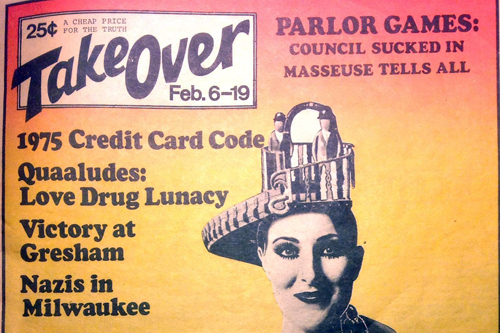
Out of that era in Madison came two enduring works of documentary: the film The War at Home (1979) by Barry Alexander Brown and Glenn Silber, and David Maraniss’s book They Marched into Sunlight (2003). Barry has gone on to be a prominent film editor, notably for Spike Lee, and Glenn went on to a career as a television documentary producer for ABC, CBS, and Frontline. Maraniss, who also attended UW–Madison, is a Pulitzer-Prize winning writer.
In a way, the 60s never left Madison. The Progressive is published here, boasting the talents of Ruth Conniff (a Madison native), Bill Lueders, and many other committed people. Our current mayor, Paul Soglin, was one of the most dynamic activists during the campus upheaval. Stu Levitan came along later and added another progressive voice to the mix. Prolific journalists John Nichols (of The Nation) and Mary Bottari (of the Center for Media and Democracy, exposer of ALEC) carry on that tradition. The Capital Times, under current editor Paul Fanlund and emeritus editor Dave Zweifel, maintains its tradition of grassroots political coverage and commentary. Ditto our free paper, Isthmus and WORT, our community radio station. One of our Senators is Tammy Baldwin, long-time top target of Koch dark dollars.
The Freedom from Religion Foundation is invigorated by the work of Annie Laurie Taylor and Dan Barker. Social struggles continue in the Hispanic and African American communities. Of course many Madison residents remember the 60s vividly, and thousands of them turn out for the street rallies and marches: opposing the invasion of Iraq (the action included the Raging Grannies ), protesting Scott Walker’s divide-and-conquer policies in service of the Koch brothers, occupying the state capitol en masse, challenging retrograde immigration policies, and organizing resistance to the ongoing Trump coup.
There was a gonzo side too. Terry Zwigoff belonged to the Society of the First Dime, a club in honor of Uncle Scrooge; Carl Barks honored the group with a drawing. When we got here people were still talking about Stuart Gordon‘s nude Peter Pan. Kentucky Fried Theater was going strong. The Onion started here, and Jim Mallon helped found Mystery Science Theater 3000. The Pail & Shovel Party planted flamingos on Bascom Hill and paid tribute to Planet of the Apes on Lake Mendota.
In short, we live in what Rush Limbaugh called The People’s Republic of Madison. We feel proud and lucky. And a bit self-righteous? Maybe, but with some reason. Recall that Wisconsin, always a state of extremes, brought America failed Prez candidate Walker, Paul Ryan, Reince Priebus (blessed by our President™), Ron “I Have an Informant” Johnson, Charlie “Don’t Blame Me” Sykes, and Glenn Grothman, the House rep honored by a John Oliver segment–and who flees his district (town pop. 463) to hang out among us and spin dad rock on WORT.
Anyhow, you won’t be surprised to learn that coming up this summer, our fair city will play host to The Madison Reunion. This “party with a purpose” on 14-16 June could not come along at a better time. There will be music, art exhibits, dance performances, and of course films at our Cinematheque. The conference will feature some remarkable panels. Brown and Silber and Maraniss will be there, of course, along with Jeff Greenfield, Errol Morris, Reina Steinzor, ZAZ, Ben Karlin, Russ Feingold, and many other alums and guests. Sessions will be devoted to influential faculty like Harvey Goldberg and George Mosse. Would they were living at this hour.
I predict that a hell of a time will be had by all. You coming? Glenn Grothman might even drop by.
Thanks to Barry Brown and Jerilyn Goodman for information about the Reunion. The Lady Liberty photo is by Angela Weier and Bryce Richter.
Stu Levitan provides a rich cultural history of 60s Madison in this article. The University library has compiled a fascinating dossier on the Sterling Hall bombing. Other blog posts on Madison and Madisonians are this very early one, this later one on movie events, and this one on Errol Morris. (Have you seen Wormwood? Very Madison.)
P.S. 13 February 2018: Thanks to Richard West for a correction about the Society of the First Dime, and to Søren Marsner who maintains the website that includes the images.
From the UW–Madison Archives.
Ninotchka’s mistake: Inside Stalin’s film industry
DB here:
It’s a commonplace of film history that under Stalin (a name much in American news these days) the USSR forged a mass propaganda cinema. In order for Lenin’s “most important art” to transform society, cinema fell under central control. Between 1930 and 1953 a tightly coordinated bureaucracy shaped every script and shot and line of dialogue, while Stalin frowned from above. The 150 million Soviet citizens were exposed to scores of films pushing the party line.
True? Not quite.
When cows read newspapers
The Miracle Worker (1936).
In the film division of the University of Wisconsin—Madison, we’ve developed a reputation for revisionism. We like to probe received stories and traditional assumptions. In Soviet film studies, Vance Kepley’s In the Service of the State challenged the idealized portrait of Alexandr Dovzhenko, pastoral poet of Ukrainian film, by tracing his debts to official ideology. In my book on Eisenstein, I suggested that this prototypical Constructivist opens up a side of modernism that is artistically eclectic, and even conservative in its gleeful appropriation of old traditions.
Now we have a new book telling a fresh story. Maria (“Masha”) Belodubrovskaya’s Not According to Plan: Filmmaking under Stalin draws upon vast archival material to argue that filmmaking, far from being an iron machine reliably pumping out propaganda, was decentralized, poorly organized, weakly managed, driven by confusing commands and clashing agendas. Censorship was largely left up to the industry, not Party bureaucrats, and directors and screenwriters enjoyed remarkable flexibility.
draws upon vast archival material to argue that filmmaking, far from being an iron machine reliably pumping out propaganda, was decentralized, poorly organized, weakly managed, driven by confusing commands and clashing agendas. Censorship was largely left up to the industry, not Party bureaucrats, and directors and screenwriters enjoyed remarkable flexibility.
Was this an ideological juggernaut? Aiming at a hundred features a year, the studios were lucky to release half that. In 1936 95 films were planned, but only 53 were produced and 34 made it to screens. From 1942 on, those millions of spectators saw only a couple of dozen annually. The nadir was 1951, with 9 releases. (Hollywood studios released over 300.) The flood of propaganda was more like a trickle. Theatres were forced to run old Tarzan movies.
When quantity became thin, apologists claimed that quality was the true goal. But Ninotchka’s hope for “fewer but better Russians” wasn’t realized in the film domain. Critics and insiders admitted that nearly all the films that struggled into release were mediocre or worse.
Not According to Plan shows that Soviet institutions were incapable, by their size, organization, and political commitments, of organizing a mass production film industry. Efforts to set up something like the U.S. studio system ran up against obstacles: there weren’t enough skilled workers, and decision-makers clung to the notion of the master director. Boris Shumyatsky, who visited Hollywood and tried to create something similar at home, got his reward at the muzzles of a firing squad. But brute force like this was rare; there were few administrators and creators to spare.
The great plan was to have a Plan—specifically, a thematic one. Production would be based on an annual cluster of powerful topics like “Communism vs. capitalism” and “Socialist upbringing of the young.” Personnel were slow to realize that themes were not stories, let alone gripping ones, and the real work of imagination remained un-plannable. Starting from themes rather than plot situations, the overseers could judge only final results, which meant enormous investments in development and production—all of which might never yield a politically correct movie.
Production, wholly divorced from distribution and exhibition, couldn’t count on the vertical integration of Hollywood. Masha shows in rich detail how policies and routines worked against large-scale output. One of the most striking of those policies was the veneration of directors. A great irony of the book is that Hollywood filmmaking, with its platoons of screenwriters both credited and uncredited, was more collectivist than production in the USSR. Soviet directors enjoyed enormous stature and power. They were often the moving force behind a production, bringing on writers and then recasting the script during shooting. Assemblies of directors formed review committees, discussing and often defending their peers’ work. As Masha puts it:
The filmmaking community, and specifically film directors, never gave up on the standard of artistic mastery. They listened to the signals sent by the Soviet leadership, but then incorporated these into their own professional value system, which developed in the 1920s outside the purview of the state. Using the state’s discourse of quality and their peer institutions, they enforced their own shared norms of artistic merit.
The downside of this system, plan or no plan, was that when the film didn’t pass muster, the director was to blame. Yet the twenty or so “master” directors could survive failed projects. New talent wasn’t trusted; there were too few directors; and most basically, the organization of production remained artisanal. The role of the producer (let alone the powerful producer) scarcely existed. To a surprising extent, Soviet cinema encouraged the director as auteur. How’s that for revisionism?
Screenwriters weren’t as powerful, but they did their part. Masha has a fascinating chapter on the changing conceptions of the Soviet screenplay. The “iron scenario,” modeled on a Hollywood shooting script, was intended to lay out the film in toto, so directors couldn’t overshoot or make changes. This initiative, predictably, failed. There followed other variants: the butter scenario, the margerine scenario, and the rubber scenario (no kidding), then the emotional scenario and the literary scenario.
Masha traces the work process of screenwriting and the mostly futile efforts of literary figures to leave their stamp on a production. A similar stress on process characterizes her occasionally hilarious case studies of censorship. Some of these expose the limits of industry self-censorship. One agency signs off on a film, the next one castigates it, the next one reverses that judgment, Pravda weighs in, and finally Stalin speaks up—with a completely unpredictable verdict, à la Trump. The tale of Medvedkin’s The Miracle Worker, which jumped through all the hoops and wound up being banned after initial screenings anyhow, might have been written by Zoshchenko or Ilf and Petrov. Among the elements judged “absolutely impermissible” were shots of cows reading newspapers.
The artistic and popular success of Soviet films during the New Economic Policy (1921-1928) had spurred hopes for a mass-market sound cinema that was also of high quality. What crushed that dream? Masha gives us the hows (the machinations of the studios and government bodies) and the whys (the underlying causes and rationales). Not According to Plan is a trailblazing study of what she calls “the institutional study of ideology.” It’s also a quietly witty account of the failures of managed culture. How could artists be engineers of human souls if they couldn’t engineer a movie?
But go back to the quality issue. What were those Stalinist films like artistically?
Socialist Formalism
Three projects I’ve undertaken led me to Stalin-era cinema. Nearly all English-language film histories ignored it, or reduced it to boy-loves-tractor musicals. So Kristin and I wanted our textbook Film History: An Introduction to consider it. (Revisionism again.) My Cinema of Eisenstein and On the History of Film Style built on what I saw at archives in Brussels, Munich, and Washington DC.
As a result I sought to mount an argument that Stalinist cinema was worth our attention, especially from the standpoint of film technique. The run-of-the-mill productions seemed fairly shambolic, but the top-tier dramas revealed an academic style that interested me. Some films recalled, even anticipated, innovations taking hold in Europe and America, but other creative choices were surprisingly offbeat, and not what we associate with standard propaganda.
For one thing, it was clear that montage experiments didn’t end with the 1920s, the arrival of sound, or even the “official” establishment of Socialist Realism around 1934. Granted, classic continuity editing rules the fiction films of the 1930s and 1940s, and the most flagrant extremes of the montage style were purged.
But some moments recall the silent era. These passages are typically motivated, as in Hollywood and other national traditions, by rapid action. Military combat calls forth stretches of 2-4 frame shots of bombardment in The Young Guard, Part 2 (1948). The combat scenes of The Battle of Stalingrad (1949) include very brief shots. In one passage, an artillery blast consists of three frames—one positive, a second negative, and a third positive again, creating a visual burst.
The abrupt disjunctions of the 1920s style can be felt a little in one cut of The Fall of Berlin (1950), when at the end of a long reverse tracking shot, Alyosha and his comrades rush the camera. Cut to Hitler recoiling, as if he sees them.
As you’d expect in an academic tradition, the use of fast cutting for fast action isn’t disruptive. A little more unusual is the embrace of wide-angle lenses, often more distorting than in Western cinema. Wide-angle imagery was used by 1920s filmmakers, often to caricature class enemies or to heroicize workers. The same sort of thing can be seen in Kutuzov (1945), when a soldier is presented in a looming close-up, or in Front (1943), when a gigantic hand reaches out for a telephone.
This use of wide angles to give figures massive bulk continued through the 1950s, as in The Cranes Are Flying (1957).
The 1940s aggressive wide-angle shots run parallel to Hollywood work, when in the wake of Citizen Kane (1941), The Little Foxes (1941), and other films, many directors and cinematographers created vivid compositions in depth. Those weren’t unprecedented in America, as I try to show in the style book, but there were some early adopters in Russia as well.
Obliged to show meetings of saboteurs, workers, generals, and party leaders, Soviet filmmakers had to dramatize people in rooms, talking at very great length. The result was a tendency toward depth staging and fairly long takes. The low-angle depth shot stretching through vast spaces became a hallmark of this academic style in the 1930s and after.
Director Fridrikh Ermler, one of the few directors who was a Party member, claimed that he devised a “conversational cinema” to deal with the prolix dialogue scenes in The Great Citizen (1937, 1939). The movie teems with shots that wouldn’t look out of place in American cinema of the 1940s.
As a solution to the problem of talky scenes, staging of this sort makes sense as a way to achieve some visual variety, and to show off production values. By the 1940s, such flamboyant depth became even more exaggerated. We see it in the telephone framing from Front above, as well as in The Young Guard Part 1 (1948, below left) and the noirish stretches of The Vow (1946, below right).
The Fall of Berlin can use depth to contrast the placid self-assurance of Stalin with a ranting Hitler, bowled over by his globe. Is this a reference to the globe ballet in The Great Dictator?
It’s well-known that for Kane Orson Welles and Gregg Toland wanted to maintain focus in all planes, sometimes resorting to special-effects shots to do so. The Soviets valued fixed focus as well, as several shots above suggest. It could be maintained if the foreground plane wasn’t too close, and the depth of field would control focus in the distance. Hence many shots use distant depth. At one point in The Great Citizen, when a woman interrupts a meeting, the official in the foreground trots all the way to the rear to meet her.
The sense of cavernous distance is amplified by the wide-angle lens.
But sometimes pinpoint focus in all planes wasn’t the goal. Another way to activate depth was to rack focus. In this scene of Rainbow (1944), the man who has betrayed the village comes home and discovers a delegation waiting to try him. At first they’re out of focus, but when he turns they become visible.
Focused or not, some of these shots push important action to the edge of visibility in a way that would be rare in American cinema. In A Great Life, a snooper is centered but sliced off by a window frame and kept out of focus, while a trial scene is interrupted by a figure far in the distance who bursts in to announce a mine collapse.
The Great Citizen shows Shakhov discussing a suspect, who hovers barely discernible in the background over his left shoulder. I enlarge the fellow and brighten the image.
This makes Wyler’s sleeve-shot in The Little Foxes seem a little obvious.
The Great Whatsis and the masters of the 1920s
The New Moscow (1938).
If American movies favor titles called The Big …., the Soviets liked The Great …. (Velikiy). But The Big Sleep doesn’t look all that big, and The Big Sick is big only to a few people, and The Big Knife doesn’t even have a knife. In the USSR, calling something big summoned up monumentality. Stalinist culture was grandiose in its architecture, sculpture, painting, literature, and even music, with symphonies of Mahlerian length and oratorios boasting hundreds of voices.
Accordingly, one effect of the depth aesthetic was to grant the characters and their settings a looming grandeur. Earth-changing historical events were being played out on a vast stage that framing and set design put before us.
Naturally, battles are on a colossal scale. Napoleon broods in the foreground (Kutuzov) and troops march endlessly to the horizon (The Vow).
1940s films feature wartime landscapes on a scale almost unknown to Hollywood. If God favors the biggest battalions, God would seem to love the Russians (a prospect that otherwise seems invalidated by history). Below: The Battle of Stalingrad.
These landscapes are surveyed in long tracking shots, a habit that survived in Bondarchuk’s War and Peace (1966-1967).
Soviet forces command impressive headquarters (The Great Change, 1945), perhaps necessary to balance the Nazis’ resources (The Vow).
Parlors and committee rooms are remarkably big, and even prison cells (The Young Guard Part 2) and farmhouses (The Vow) have plenty of room.
Gigantism wasn’t unknown in 1920s cinema, or in Russian painting both classic and recent. The Vow seems to justify its scale by reference to a Repin painting, which the characters see on display.
Not only were the 1920s silent classics monumental; they became monuments. Masha records the veneration that the “master” directors felt for the works of Eisenstein, Pudovkin, Kuleshov, Barnet, and other predecessors. Moments in the Stalinist cinema seem to refer back to that era. The Battle of Stalingrad evokes the mother with the slain child on the Odessa Steps, and The Vow has the nerve to superimpose on Stalin (friend of farmers) an image of concentric plowing from Old and New.
These can be taken as cynical ripoffs, but in a way they testify to the fact that great silent films had forged some enduring iconography.
VIP: Very important, Pudovkin
You don’t hear much about Pudovkin’s 1930s and 1940s films, but they can be exuberantly strange. Eisenstein aside, he stands in my viewing as the director who played around most ambitiously with the academic style. Perhaps he was encouraged in this by his young codirector Mikhail Doller, but Pudovkin had already tried out some audacious strokes in A Simple Case (1932) and Deserter (1933).
For a high Stalinist example take Minin and Pozharsky (1939). This tale of seventeenth-century warfare seems virtually a reply to Alexander Nevsky (1938), as Mother (1926) responded to Strike (1925). Minin opens with statuesque staging reminiscent of Eisenstein’s film, but the scene is handled in telephoto shots and to-camera address. The combat scenes employ handheld battle shots, along with close-ups of fighters and horsemen that aren’t stylized in the Nevsky manner.
But there’s more than pastiche here. One battle shows the Russian forces rushing from the left in tight tracking shots, while the enemy forces move from the right in panning telephoto. Especially striking are axial cuts, beloved of Soviet filmmakers for static arrays, employed in movement. Horses sweep past a tent in extreme long-shot; they smash into the tent in long shot; and in a closer view the tent lies trampled as other horses continue to flash through the foreground.
The shots are 50 frames, 38 frames, and 13 frames respectively. For a moment, we might be back in the great era of Soviet editing.
Victory from 1938 is a drama in which aviators set out to rescue an interrupted around-the-world flight. Here Pudovkin and Doller invoke the depth staging of the era only to disrupt it with what we might call “smear” cuts.
During the parade for the departing airmen, for instance, a young man happily tossing papers, in another grotesque wide-angle shot. He’s blocked by a man passing through the frame. Match on action cut to another figure, close to the camera and moving in the same direction. This figure wipes away to reveal a man reading a newspaper.
This sort of weird graphic match becomes a stylistic motif in the film. Later, when the rescue has been completed, another crowd scene yields a similar pattern of depth smeared and exposed. A shot of the parade is sheared off by a woman’s passing face. That cuts to a man’s passing face, which moves away to show the crowd behind him.
The patterning pays off when the victorious plane rolls triumphantly through the frame, blotting out the image, to be graphically matched by a passing figure who unveils the pilot’s mother embracing him.
In Admiral Nakhimov (1947) Pudovkin and Doller employ the smear-cutting technique during a battle scene. Stills are totally unable to capture the way this looks. Soldiers charge up a hill, and their falling bodies, briefly blocking the camera’s view, are given in jump-cut repetitions that suggest, through a spasmodic rhythm, the sheer difficulty of advancing.
Even stranger is the moment when soldiers rush toward a distant fortification, with a latticework basket in the foreground. Cut to the hill edge, with a comparable blob moving leftward through the frame. It turns out to be a fighter’s shoulder.
The oddest part is that this second shot is only six frames long, and every frame after the first is a jump cut; that is, some frames have been dropped as the blob makes its way across the image. The effect on your eye is percussive, and seems to be anticipated by Pudovkin’s experiments in popping black frames into shots in A Simple Case. What kind of director thinks like this?
Of course these Pudovkin/Doller films also subscribe to the official look, with monumental depth staging. The films acknowledge the 1920s tradition as well. Admiral Nakhimov casts a personal look back to Pudovkin’s great rival. A shot of the crew’s tautly bulging hammocks recalls, maybe cites, the crew’s sleeping area of Potemkin.
In Odessa, Admiral Nakhimov echoes Potemkin even more strongly. We get waving crowds, the stone lions, and a reminder of those famous steps.
In sum, the Stalinist cinema holds a unique interest for students of the history of film style. Not only did it apparently constitute a significant development in technique, but in forming a tradition, it provided a counterpart and sometimes a counterpoint to developments in the West. Later that tradition became something for directors to react against (Tarkovsky and Sokurov come to mind) or to adapt to new purposes (I’d put Jancsó in that category). For all the behind-the-scenes bungling, it became much more than a propaganda vehicle.
Scholars who study Stalinist film are usually impelled by an interest in propaganda or an interest in the audience’s response. My questions were different. I was driven by my interest in Eisenstein and comparative stylistics. So I tried to investigate the formal and stylistic norms of Soviet cinema. Some of those norms Eisenstein helped create, and then revised for his own ends.
Still, I feel like a butterfly collector picking out vivid specimens for an expert to explain. I can’t supply the hows and whys. How did filmmakers manage to create these remarkable images? What technical resources, of lenses and lighting rigs and film stock and set design, permitted them to craft these striking shots? Were their peers and masters insensitive to this official look? Was it taken for granted? Or was it self-consciously promoted and taught? Some of these schemas are developed in Eisenstein’s lectures at the Soviet film school. And how, at a more micro-level, do these patterns function in the individual films?
As for the whys: Why did filmmakers embrace these options rather than others? And why did they develop, sometimes apparently in a spirit of play, some oddball technical innovations?
Such questions seem to me compelled by films that turn out to be more artistically interesting than most commentators have noted. One of the most corrupt and brutal political systems in world history produced films of considerable interest, and a few of enduring value. I hope experts try to figure this all out. I bet Masha Belodubrovskaya will lead the way. Her new book is a splendid start.
Masha is no stranger to this blog, having translated Viktor Shklovsky’s remarkable “Monument to a Scientific Error” for us.
This is a good place to thank all the people who helped me see Stalinist films in archives over the decades. That number includes Gabrielle Claes, Nicola Mazzanti, and the late Jacques Ledoux of the Belgian Cinematek; Enno Patalas, Klaus Volkmer, and Stefan Droessler of the Munich Film Museum; and Pat Loughney, then of the Library of Congress.
I learned of Ermler’s “conversational cinema” (razgovornyi kinematograf) from Julie A. Cassiday’s “Kirov and Death in The Great Citizen: The Fatal Consequences of Linguistic Mediation,” Slavic Review 64, 4 (Winter 2005), 801-804. The depth aesthetic of high Stalinist cinema proved valuable when 1960s bureaucrats decided to make Stalin disappear. See our online supplement to Film History: An Introduction.
There are more examples of “Stalinist formalism” in On the History of Film Style–recently declared out of print, but soon to appear in a new electronic edition on this site. See also my Cinema of Eisenstein for arguments about how he created and then swerved from some of his peers’ norms.
Today’s Google Doodle pays tribute to Eisenstein on his birthday. But they make him a slim, hip metrosexual. Revisionism can go too far.
Kelley Conway, Masha, and Scott Gehlbach, at a party last night celebrating Masha’s book–and her winning tenure! Kelley’s contributions to our blog are here and here and here.
Dreyer, and more, in Houghton
La Passion de Jeanne d’Arc (1928).
DB here:
Erin Smith, of Michigan Technological University, distinguished herself during her years at Madison as a grad student in both English and Film. She’s moved more fully into media studies and production, including documentary work. When she invited me to visit 41 North Film Festival this coming weekend, how could I refuse?
There’s a lot going on, most elaborately a screening of Dreyer’s La Passion de Jeanne d’Arc with orchestral and choral accompaniment.
I’ve never attended a performance of Richard Einhorn’s score, so this should be quite something. (The Criterion DVD version of the film offers it as optional accompaniment.) In addition, there are several other films showing over the weekend. You can go here for the full schedule, which includes one of our recent favorites, Varda’s Faces/Places.
While Kristin and I are there, I’ll be doing a lecture on Dreyer and another talk based on Reinventing Hollywood.
My first book was a little guide to La Passion de Jeanne d’Arc, and my second book was a survey of Dreyer’s films. I’ve returned to him sporadically since then, and I’ve had occasion to rethink his role in film history–especially in light of my and others’ research on silent cinema. (For example, “The Dreyer Generation,” “Dreyer Re-Reconsidered,” “Nordisk and the Tableau Aesthetic,” and this blog entry on Criterion’s Master of the House release.)
Dreyer remains for me an impressive, enigmatic figure. He was sensitive to the changing styles of cinematic expression from the 1920s to the 1960s, and yet he went his own way. His early silents were au courant with trends in European filmmaking, especially kammerspiel. Yet Jeanne was one of the wildest movies of the era, a hallucinatory blend of Expressionism, French Impressionism, and Soviet Montage. It still seems to me resolutely unique, which partly secures its timelessness.
After the no less weird Vampyr (1932), Dreyer’s films seemed old-fashioned in their pacing; even Danish critics called Day of Wrath (1943) sluggish. Yet as things played out his “archaic” style in the sound era looks more and more prophetic. He said he learned from Antonioni, but Ordet (1955) and Gertrud (1964; below) go far beyond the deliberate pacing of European films of his day and look forward to Straub/Huillet and Béla Tarr.
Was he the first director of “slow cinema”? I now see him as integrating principles of the “theatrical” cinema of the 1910s–a style he rejected in his youth–into the modern sound cinema, in effect showing the continued viability of the approach, while pushing it to extremes. Just like what he did with editing and shot design in Jeanne, come to think of it. For such a quiet guy, he was pretty bold.
Michigan Tech is located in gorgeous country (the UP, as we midwesterners call it). Kristin and I look forward to our road trip, accompanied by old Orson Welles radio shows. We thank Erin and her colleagues for inviting us!
A view of Houghton, MI, from the Portage waterway.












